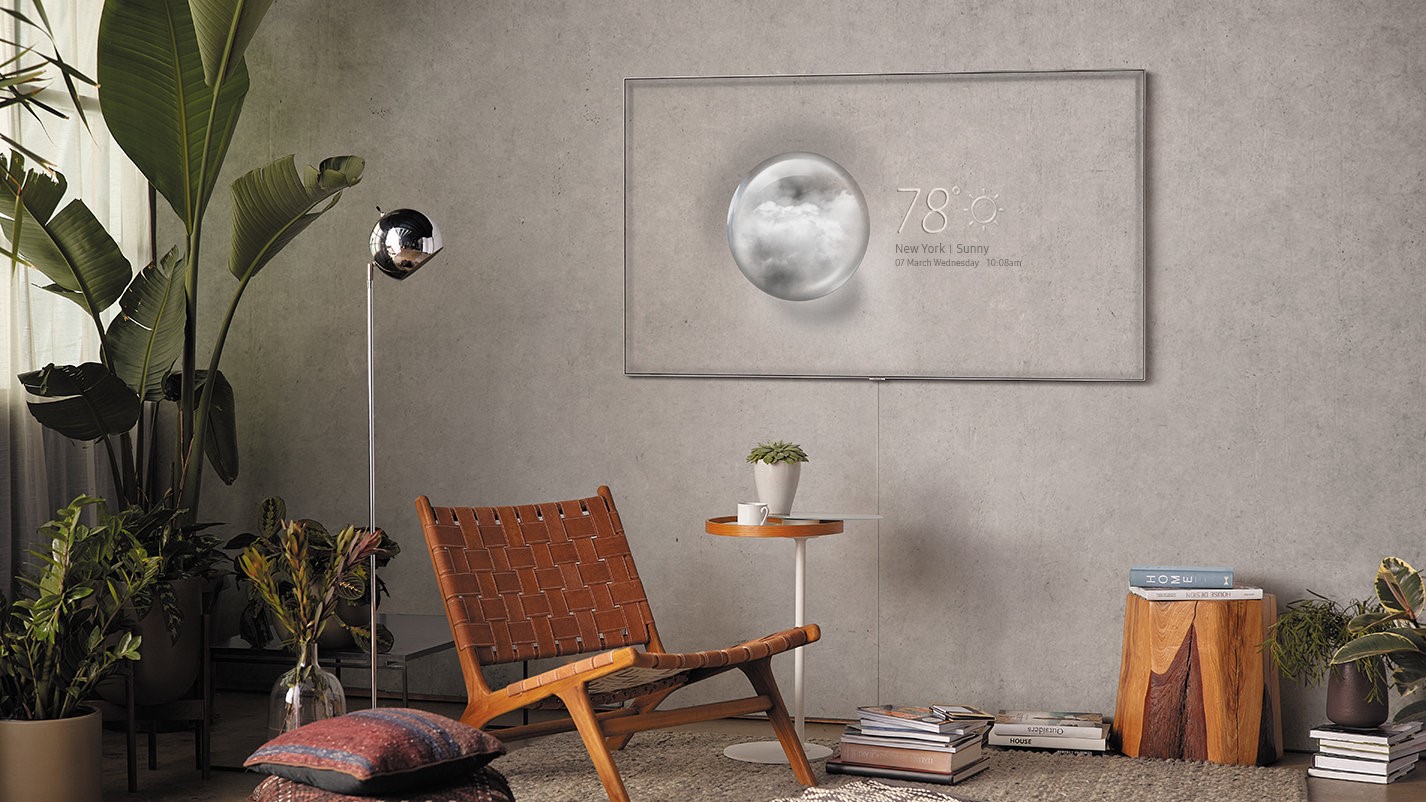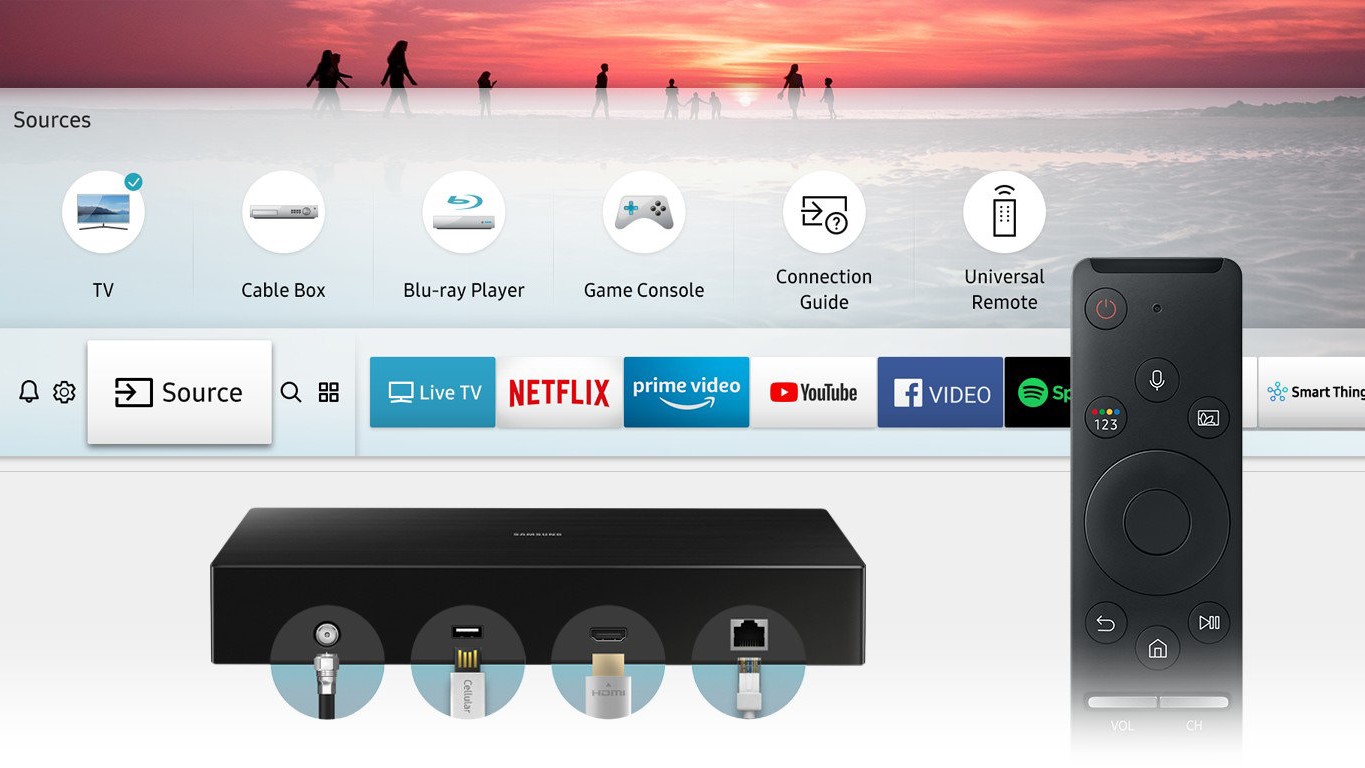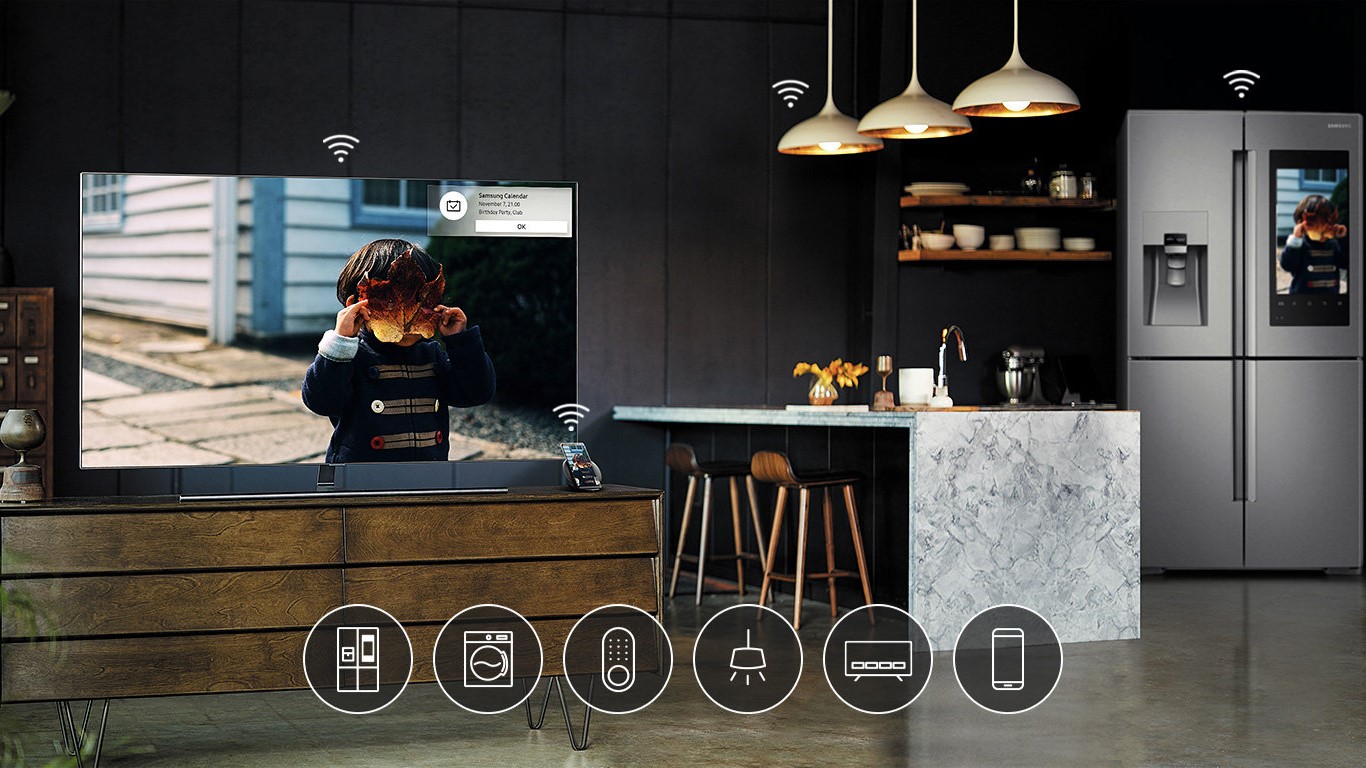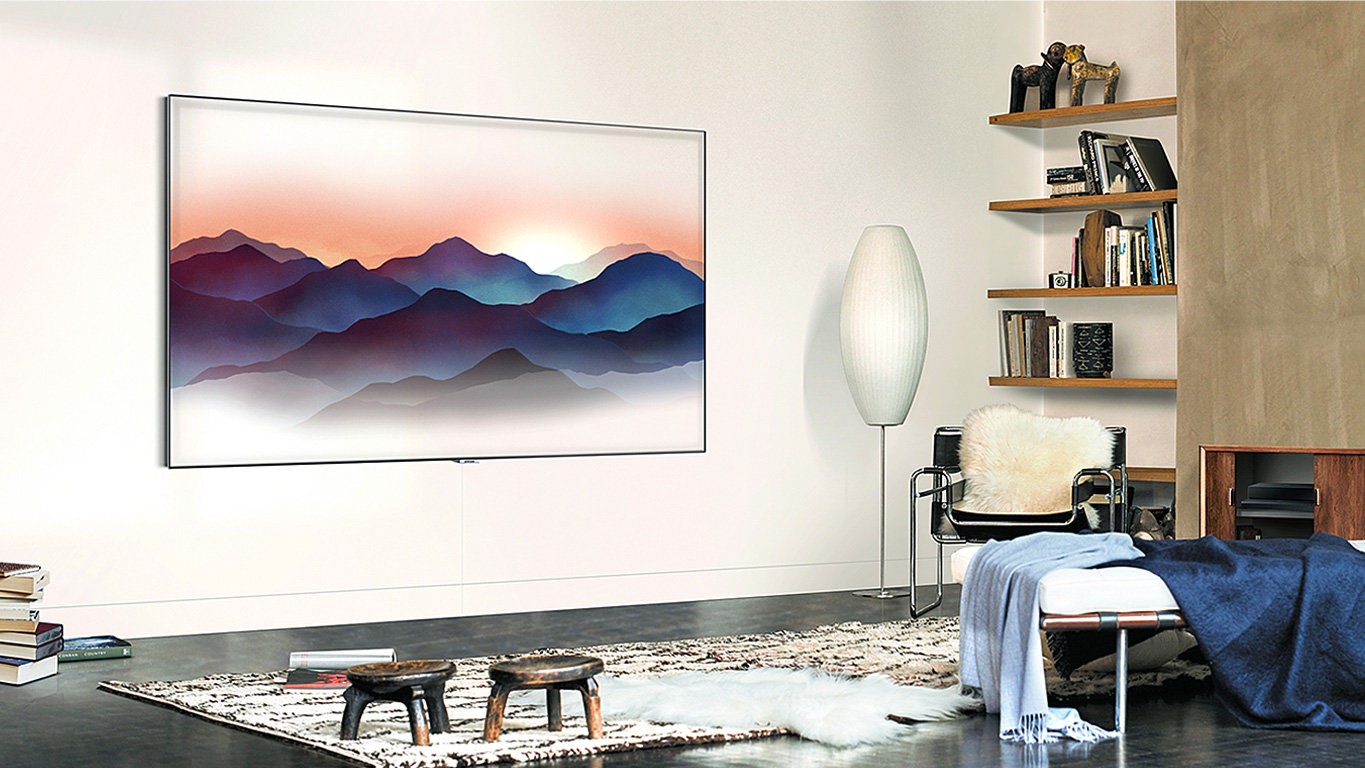TechRadar Verdict
The Samsung Q7FN QLED TV has most of what makes the class-leading Q9FN great: Its quantum dots help produce a colorful but not oversaturated image and local dimming has really improved year-on-year. That said, off-axis viewing is still an issue and motion handling isn’t as good here as it is on Sony’s similarly priced X900F (XF90) BRAVIA series.
Pros
- +
Minimalist appearance
- +
Startling color accuracy
- +
Great for daytime viewing
Cons
- -
Edge-Lit VA panel
- -
Limited viewing angles
- -
Motion handling
Why you can trust TechRadar
Samsung’s 2017 QLED TVs were a showcase for what metallic quantum dots could do for 4K HDR TVs. And while we can all agree that those TVs were bright, bold and beautiful, they were missing some essential components that made rival sets perform even better in areas like contrast and off-axis viewing angles.
Faced with these issues, Samsung went back to the drawing board and emerged in 2018 with the Samsung Q9FN QLED. It packs in a number of panel technologies to fix the places where QLED faltered, like full-array local dimming with Q Contrast EliteMax, and the results are truly spectacular.
But, unfortunately, not all of that picture technology made it to the Q7F.
The second-tier Q7FN doesn’t offer full-array local dimming, for example, and while it still outputs a tremendous amount of light, all of that detail can be lost if you move just a few degrees to the left or the right of the screen.
That said, while Samsung’s second-tier Q7FN isn’t quite the screen the Q9FN turned out to be, it’s still a brightly lit, formidable telly for 4K HDR enthusiasts.
- Read our full guide to what makes QLED panels tick
- Or weigh up the differences in our QLED vs OLED guide

Price and release date
We’ll be specifically looking at the 55-inch QN55Q7FN in this review, however there are a number of other Q7FN models that all use the same panel technology in different screen sizes. To that end, there’s a 65-inch QN65Q7FN and a 75-inch QN75Q7FN. All models of the Q7FN are available now, and will run you $1,799, $2,499 or $3,799, depending on which screen size you go with.
If you live overseas in Europe, you can find 55-, 65- and 75-inch versions of the Q7FN that are called the QE55Q7FN, QE65Q7FN and QE75Q7FN, respectively, and will run you £1,999, £2,699 or £3,999 depending on which size you go for.
Sign up for breaking news, reviews, opinion, top tech deals, and more.
For Australian TV buyers, there’s the QA55Q7FN, QA65Q7FN and QA75Q7FN which cost AU$3,699, AU$5,299 and AU$8,199, respectively.
The next step up from the Q7FN is the Q8FN, which is available starting at $2999 (about £2,200, $AU4,000), and the Q9FN that costs $3,800 (about £2,720, AU$4,835) but includes Samsung’s ‘No Gap Wall Mount’.

Design
While LG has the market cornered on nearly invisible frames with its nearly borderless W8 OLED, Samsung's Q7FN isn’t far behind. The Q7FN uses Samsung’s signature T-Bar stand to hold the TV up and tuck cables into the back. This makes for a quick setup and clean look when it’s all finished.
The TV has a silver frame with a thin, eighth-inch bezel. It’s not invisible to the eye, but it’s pretty thin all things considered. Depth-wise the screen sits at half-an-inch near the top and a full inch near the the bottom of the screen.
You'll notice that it’s larger around the lower half of the TV because that’s where the edge-lit LEDs sit. That’s also where the TV’s only port is - Samsung’s proprietary ‘invisible’ connection cable that runs to an external processing unit that Samsung has dubbed the One Connect box. It’s there you’ll connect devices to any one of the four HDMI ports, single digital optical-audio out or ethernet ports. Speaking of, the One Connect box is fairly bulky and can mar the appearance of a home theater setup, however, because the cord that runs between the One Connect box and the TV itself is fairly small and rather lengthy, you hide the box in a cabinet, paint the cord the same color as the wall and the TV will remain clutter-free.
The other unique design feature on Samsung’s 2018 QLED TVs is Ambient Mode, a low power consumption setting that helps the TV blend into the background when not in use. While it’s hard to describe in a lot of detail, we'd say it’s a cross between a standard screen saver and a photo you take of the wall behind your TV.
It's similar, in some ways, to an Apple Watch face - you’ll find a whole library of designs to pick from when you enter Ambient Mode, and Samsung can always add more of these via software update later. That being said, right out of the gate it’s a feature that helps separate Samsung from the competition and really does help the TV look more at home when not in use.
Design TL;DR: The Samsung Q7FN is a beautifully minimalistic TV - with or without Ambient Mode turned on. The One Connect box required to power the TV is a bit bulky, but you can thankfully squirrel it away in a cupboard with relative ease.

Smart TV features
The good news continues with the Q7FN’s smart TV features - Samsung’s Eden-based OS is beautifully designed and easy to use. Like last year, apps are lined up along the bottom row and you’ll find all the main culprits here - Netflix, Amazon and YouTube come pre-installed with the TV. (UK owners will also receive catch up apps for all four of the country’s main terrestrial TV broadcasters while US streaming enthusiasts will see Hulu and Sling TV.)
New for 2018, however, is the integration of Bixby, Samsung’s virtual assistant, and Samsung SmartThings, which allows you to control IoT devices around the house using the microphone built into the remote itself.
That said, while Bixby has the power to track down shows, control the smart home and answer queries it rarely does any of the above phenomenally well. Search for “Thor”, for example, and Bixby will insist it heard “Four” or search “Star Wars The Last Jedi” and it’s likely to hear “Star Wars Las Jedi” - which sounds like the name of a Star Wars-themed bar and grill in Las Vegas, Nevada.
Because this is Samsung’s first year with Bixby integration it’s fine to cut them some slack in this department. Heck, Siri has been in Apple devices for the better part of a decade and it still confuses words all the time. The counter-point here, though, is that LG has opted to use Google Assistant in its latest version of WebOS and it’s a much better experience.
If you can look past the occasional misinterpretation, what you are treated to is a phenomenally robust, blazing fast OS. Navigating the nooks and crannies of Tizen feels like an exciting treasure hunt as you never quite know what goodie you’re going to uncover next.
Smart TV TL;DR: Tizen is one of the best smart platforms on the planet. Now if only Samsung would’ve used Google Assistant instead of Bixby...

HD/SDR Performance
Like the rest of its siblings in the 2018 QLED line-up, the Samsung Q7FN offers seriously good upscaling of HD/SDR content. The result is a picture that has added detail with very little picture noise. (It’s still there, but it’s minimal at distances beyond a few feet away.)
The big benefit to HD/SDR performance, and probably the TV’s biggest boon period, is its brightness. Sure, HD/SDR content only requires around 300 to 400 nits of peak brightness to display every detail, but it doesn’t hurt that this TV can get much, much brighter.
To take advantage of this extra brightness with HD/SDR content, every new 2018 Samsung 4K HDR TV has a mode called HDR+ that expands its colors and opens up the contrast of the screen. It’s not quite as good as having content shot in native HDR, but with HDR+, HD/SDR content won’t look half its age and you’ll get more of a dramatic contrast when watching older films that weren’t shot in the latest format.
One downside here, and it was something we pointed out in our review of the Samsung NU8000 series earlier this year, is that HDR+ changes the color tone to warm, which adds a sepia-like hue to the image. It’s not a huge deal, but if you want to return the screen to a cooler, more normal-looking image, you’ll need to go into the settings and manually reset the color tone.
The other, much larger issue, and something we’ll talk about more in the next section is that the Q7FN uses an edge-lit, VA LED panel instead of going full-array. This isn’t something that you’ll notice in HD/SDR content - as the contrast ratio between the brightest whites and darkest blacks isn’t that pronounced - but it can sometimes affect the picture here, too.
HD/SDR Performance TL;DR: While HDR+ Mode dramatically enhances the color and contrast of HD/SDR images, AV purists will find plenty to love with the Q7FN’s strong performance with native HD/SDR content.

4K/HDR Performance
We’ve covered brightness in the section above, but it’s worth reiterating here as the uptick in nits really helps the Q7FN take advantage of High Dynamic Range content.
According to Samsung, the Q7FN is capable of brightness in the 1400 to 1600 nit range, making it twice as bright as rival LED-LCD screens and well above the recommended 1,000-nits set by the UHD Alliance. This extra brightness makes it great for daytime viewing and gives the Q7FN near-OLED levels of contrast.
Unfortunately, though, it’s still an edge-lit VA LED panel.
That means the TV has great contrast - especially in dark rooms and especially when you sit squarely in front of the screen - but still requires an LED panel in the back, unlike OLED, and therefore doesn’t offer quite the same black level performance or great off-axis viewing.
Speaking of off-axis viewing, if you sit a few degrees to the left or the right of the screen, it’s fairly easy to notice some desaturation. While we don’t have a precise measurement, you should absolutely avoid sitting any more than 30 degrees in either direction and, if you can help it, even less than 15 or so degrees. That rule applies both horizontally and vertically if you decide to wall mount the screen.
It’s not all bad, though. Because of the massive amount of brightness these TVs can output in HDR, they looks great even in broad daylight. Add to this the benefits of the quantum dot technology that enhances color volume, and you’ve got a picture that is truly tremendous - even if it’s not exactly the best picture performance on the market.
Speaking of HDR, it’s worth noting that as of right now, the Samsung Q7FN only supports HDR10, HLG and the still-nascent HDR10+. Samsung hasn’t adopted Dolby Vision yet, which means most Netflix original shows will show up as standard HDR instead of Dolby Vision - which is kind of a bummer.
While it wasn't available to stream in Dolby Vision, Defenders in HDR on Netflix still looks incredible: characters’ costumes looked crystal clear and color accurate, and dark scenes retained details even in the middle of massive fight sequences. Similarly, Planet Earth 2 looked outstanding in 4K HDR although we noticed a distinctive green hue that made jungle scenes look more lush, if a little oversaturated.
Last but not least, gamers will find a lot to love about Samsung’s 2018 Q7FN line-up as it supports Auto Game mode which can detect when you’re playing a console or PC game and automatically switch the screen into its fast-responding Game picture mode. Samsung also has plans to add Variable Refresh Rate sometime down the road which will help with any screen tearing you might’ve noticed in years past as well as bring the input lag to a remarkably low 7ms. (We measured the Q9FN at still-respectable 34ms, for reference.)
4K/HDR Performance TL;DR: Bright and colorful the Q7FN is a great 4K HDR TV. Just make sure you sit directly in front of it.

Sound
To bolster the Q7FN’s picture performance is a surprisingly powerful audio system. It’s more than you’ll need to hear most TV and movie dialogue above the background noise, and it does a respectable job with music - even if it’s not our first choice for a house party setting.
That being said, while audio performance is fairly strong, it’s the features that Samsung packs into the Q7FN that make it well worth its weight in amplifiers. Namely, that includes easy-to-setup Bluetooth pairing that allows you to use your TV as a speaker for your phone or tablet and the inclusion of Chromecast Built-In that lets you cast at the drop of a hat.
On top of all that is Samsung’s Smart Sound feature, a unique software algorithm Samsung’s TV division has lifted from its California-based audio lab that analyses the incoming sound and automatically adjusts it to suit the type of content you’re watching.
In practice Samsung’s TV hardware and software create a strong audio performance, one that should easily fill most rooms with loud, clear dialogue and realistic sound effects. Will it replace your soundbar or surround sound speaker system? No. But can the Q7FN stand on its own without the help from an external audio setup? Absolutely.

Other panels to ponder
Let it be known that Samsung’s Q7FN is not an inexpensive TV - at $1,799 (£1,999, AU$3,699), it’s entry-level in name only. If money's tight, you can drop down to the Samsung Q6FN, but you’re better off sticking with the Q7FN if you can afford it.
Better, however, would be if you could upgrade to the Samsung Q9FN - we aren’t kidding when we say that’s the best TV on the market in 2018. It offers a full-array panel which means even better contrast and more accurate HDR images. It’s a pricey investment, yes, but in this case you get what you pay for.
If you’re looking for something that’s close in price to Samsung’s Q7FN, many of LG’s Super UHD TVs fit the bill, including the LG SK85 (SK8500) and LG SK95 (SK9500). Both of these TVs use a variation of quantum dot and offer better viewing angles than Samsung’s QLED. What we didn’t like about these TVs when we saw them is that they have black level uniformity issues. Can't win 'em all, I suppose.
Your other option would be Sony’s X900F (XF90) Series. It’s full array and offers amazing upscaling for HD/SDR images as well as world-class motion handling. It has similar issues with light bleeding as LG’s Super UHD TVs and the limited viewing angles that you’d find on the Q7FN but excels everywhere else.
Last but not least, if you don’t mind some compromises in overall color volume and accuracy, we’d be remiss not to mention the TCL 6-Series 4K Roku TV. These are ultra-affordable HDR screens that pack in Dolby Vision on top of a well-stocked OS that has every streaming service under the sun. Pricing for the 55-inch TCL 55R617 TV starts at just $649.
Verdict
While Samsung’s Q7FN is one of the better screens available this year, it’s not quite the pinnacle of QLED technology - that honor is reserved for the Q9FN. The Q7FN is a great compromise between price and performance offering a bright screen, three forms of HDR and incredibly accurate colors for $1,799 (£1,999, AU$3,699), yes, but there’s still some room for improvement on this year’s Q7 series.
That said, while the Q7FN is bright, colorful and beautiful, it loses many of those qualities the moment you shift a few degrees off-axis. This isn’t an area where some of Samsung’s competitors - like the LG OLED or Super UHD TVs - stumble, and that makes it tough to give a full unadulterated recommendation.
If you can overlook those qualities, however, the Q7FN has a lot to offer. Ambient Mode adds a design aesthetic sure to please even the keenest of eyes and its low-latency game mode makes it a competent companion for the Xbox One X and PS4 Pro. HDR+ mode helps liven up HD/SDR content and of course 4K/HDR content has an eye-watering sheen when viewed on this set. While the Q7FN isn’t quite a homerun, it’s still a solid swing at the mid-range.
- These are the best 4K TVs in 2019

Nick Pino is Managing Editor, TV and AV for TechRadar's sister site, Tom's Guide. Previously, he was the Senior Editor of Home Entertainment at TechRadar, covering TVs, headphones, speakers, video games, VR and streaming devices. He's also written for GamesRadar+, Official Xbox Magazine, PC Gamer and other outlets over the last decade, and he has a degree in computer science he's not using if anyone wants it.
